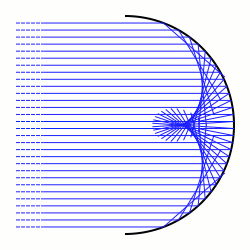Top Qs
Timeline
Chat
Perspective
Pearcey integral
Class of canonical diffraction integrals From Wikipedia, the free encyclopedia
Remove ads
In mathematics, the Pearcey integral is defined as[1]


The Pearcey integral is a class of canonical diffraction integrals, often used in wave propagation and optical diffraction problems[2] The first numerical evaluation of this integral was performed by Trevor Pearcey using the quadrature formula.[3][4]

In optics, the Pearcey integral can be used to model diffraction effects at a cusp caustic, which corresponds to the boundary between two regions of geometric optics: on one side, each point is contained in three light rays; on the other side, each point is contained in one light ray.
Remove ads
References
Wikiwand - on
Seamless Wikipedia browsing. On steroids.
Remove ads

